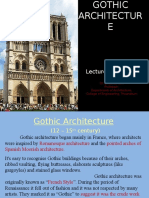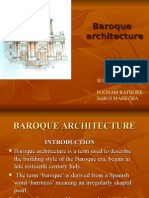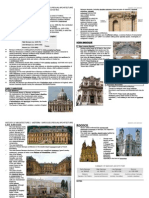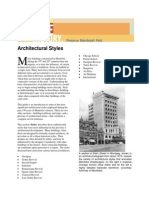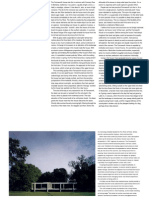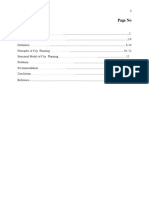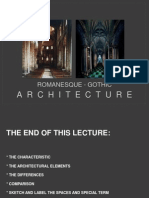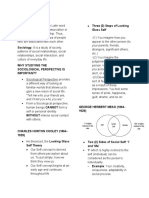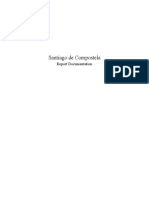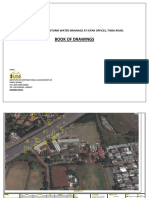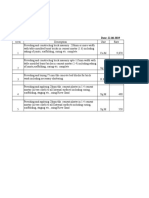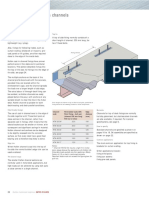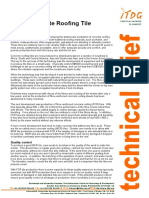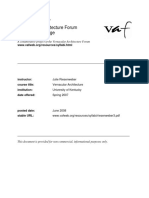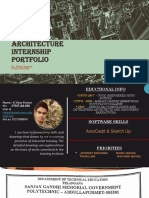Professional Documents
Culture Documents
Renaissance Architecture
Renaissance Architecture
Uploaded by
PaulaTrishaValleOriginal Title
Copyright
Available Formats
Share this document
Did you find this document useful?
Is this content inappropriate?
Report this DocumentCopyright:
Available Formats
Renaissance Architecture
Renaissance Architecture
Uploaded by
PaulaTrishaValleCopyright:
Available Formats
RENAISSANCE ARCHITECTURE than being created by intuition as
Medieval Buildings.
- Renaissance means rebirth
- Renaissance Architecture means
“The rebirth of Classical
Architecture”
- It is the architecture period between
the early 15th and early 17 centuries
in different regions of Europe,
demonstrating a conscious revival
and development of certain
elements of ancient Greek and
Roman thought and material culture.
- Originated in Florence, Italy
Filippo Brunelleschi
INFLUENCES
- A quattrocento architect is best
- Warfare was changed by the known for designing the dome of the
invention of gunpowder, which Duomo in Florence. (true cathedral)
brought about the need of a new - In 1420, he began to design the
building type. dome of Florence Cathedral, the
- Increased understanding of Science largest since the Hagia Sophia.
and the Arts, Medicine and - The dome was built without
Astronomy, and Human Anatomy
employing centering to support the
- Artists attempted to understand the masonry.
ancient world, its values, literary, dome of
artistic forms, and architectural Florence
forms Cathedral
THREE PHASES
- Early Renaissance, also known as
Quattrocento (ca. 1400-1500)
- High Renaissance (ca. 1500- 1525)
- Mannerism (ca. 1520- 1600) also
known as Late Renaissance
- Baroque
Early Renaissance/ Quattrocento
- In the Quattrocento, concepts of
architectural order were explored,
and rules were formulated Michellozzo Di Bartolomeo
- The study of classical antiquity led in
particular to the adoption of - A quattrocento architect
Classical detail ornamentation - Famous work was Pallazo Medici
- Space was organized by Riccardi. A decade later he built the
proportional logic, its form and Villa Medici at Fiesole.
rhythm subject to geometry, rather
- On - He designed several buildings, but
e unlike Brunelleschi, he did not see
of himself as a builder in a practical
sense and so left the supervision of
the work.
the first
- Dynamic buildings
architectures to work in the
Renaissance style outside Italy.
- Triumphal facades marked by
Palazzo Medici Ricardi
extreme contrasts. Projection of the
order of pilasters that define the
architectural elements.
- The light and shade play
dramatically over the surface of the
Palazzo Medici Ricardi building.
- was different for its time, and was
- Works: San Andres Mantua, Palazzo
the start of several architectural
Rucellai and Santa Maria Novella
breakthroughs.
- First building in the city to be built
Palazzo Rucellai
after the modern order including its
own separate rooms and apartments
- The prototype Tuscan Renaissance
Palazzo.
- Use of threefold grading of masonry,
rusticated blocks on the ground
floor, the ashlar face of the top
storey and the cornice.
- Rusticated blocks soon became
seen as a status symbol as the
materials were costly and rare.
- Rustication is a range of masonry
techniques used in classical
architecture giving visible surfaces a
finish texture that contrasts with
smooth, squared-block masonry
called altar.
- Ashlar is finely dressed (cut,
worked) stone, either an individual
stone that has been worked until
squared, or a structure built from
such stones.
Leon Battista Alberti
- Michelangelo’s dome in Saint Peter
Santa Maria Novella, Florence was a masterpiece of design using
two masonry shells, one within the
other hand and crowned by a
massive lantern (same as Florence).
- Laurentian Library
High Renaissance
- During the High Renaissance,
concepts derived from the classical
antiquity were developed and used
with greater surety.
- The most representative architect is
Donato Bramante (1444 – 1514)
who expanded the applicability of
classical architecture to
contemporary buildings
Mannerism
- During the Mannerist Period,
architects experimented with using
architectural forms to emphasize
solid and spatial relationships. The
Renaissance ideal of the harmony
gave way to free and more
imaginative rhythms.
- Best known architect associated with
the
Mannerist Style was Michelangelo
(1475-1564)
- A transitional style in European
architecture in the late 16th century,
particularly in Italy, characterized by
the unconventional use of classical
elements. In the fine arts,
- Mannerism was chiefly
characterized by a distortion of
perspective, elongated forms, and
intense, often strident color.
Michelangelo
- Michelangelo di Lodovico Buonarroti
Simoni.
Sistine Chapel square plan with four facades, each
of which has a projecting portico.
Villa Capra
St.
- The name ‘La Rotunda’ refers to the
central circular hall with its dome.
- Each portico has steps leading up,
Peter’s Church Dome
and opens via a small cabinet or
corridor to the circular domed central
hall
- The design reflected the humanist
Porta Pia
values of Renaissance Architecture.
Laurentian Library
In order for each room to have some
Andrea Palladio sun, the design was rotated 45
degrees from each cardinal point to
- Palladio was to transform the
the compass
architectural style of both palaces
- Each of the four porticos has
and churches by taking a different
perspective on the notion of pediments graced by statues of
Classicism. classical deities. The pediments
were each supported by six ionic
- When he used the ‘triumphal arch’
columns.
motif of a large arched opening with
-
lower square- topped opening on
either side, he invariably applied it
CHARACTERISTICS AND ELEMENTS OF
on a small scale such as windows.
RENAISSANCE ARCHITECTURE
- Ancient Roman motif is often
referred to as the Palladian Arch
1.) Plan – the plans of Renaissance
- Villa Capra
buildings have a square, symmetrical
- San Giorgio Maggiore
appearance in which proportions are usually
- The site selected was a hilltop just based on a module
outside the city of Vicenza, Italy. The - The need to integrate the design of the
building was designed for a site plan with the facade was introduced as an
which was suburban.
issue in the work of Filippo Brunelleschi, but
- The design is for completely he was never able to carry this aspect of his
symmetrical building having a work into fruition.
- The development of the plan in secular
architecture was to take place in the 16th
century and culminated with the work of
Palladio.
Ex. Sant Andrea, Mantua by Leon Batista
Alberti
- 4.5 m internal diameter
- Site where St. Peter was martyred
- Designed by Donato Bramante
- Dome on drum pierced with alternating
windows and shell-headed niches
2.) Façade – Facades are symmetrical
around their vertical axis. Church facades
are generally surmounted by a pendiment
- Medici family - founded by Giovanni de and organized by a system of pilasters,
Medici, who was a commercial and political arches, and entablatures. The columns and
power windows show a progression towards the
- Vitality of social life at every level center.
- Artists, who excelled in several arts, - Domestic buildings are often surmounted
achieve high status in society by a cornice. There is a regular repetition of
- Craft guilds, with both religious and lay openings one each floor, and the centrally
connotations, directed activities of studios placed door is marked by a feature such as
and workshops balcony, or rusticated surround.
- Renaissance had its birth in Florence 3.) Elements: Columns and Pilasters
- The Roman orders of columns are used:
PALAZZI Tuscan, Doric, Ionic, Corinthian, and
- With the development of gunpowder, Composite.
palace-type building evolved, taking the - The orders can either be structural,
place of fortified castles supporting an arcade or architrave, or
- Built around a cortile or interior court, like purely decorative, set against a wall in the
medieval cloister form of pilasters.
- Ground floor and piano nobile - During the Renaissance, architects aimed
- Façade of massive, rugged, fortress-like to use columns, pilasters, and entablatures
character due to use of rusticated masonry as an integrated system.
and wall angles called quoins
- Large windows unnecessary and
unsuitable
- Low pitched roof covered by a balustrade,
parapet or boldly protruding roof cornices
- Palazzo Strozzi
- By Benedetto da Majano
- Representative of the Florentine palace of 4.) Elements: Arches
that period - Arches are semi-circular or (in the
- Open cortile and piano nobile Mannerist style) segmental. Arches are
- Astylar exterior of uniform rustication often used in arcades, supported on piers or
- Cornice of 1/13 the height, 2.1 m columns with capitals.
projection - There may be a section of entablature
- Splendidly presented examples of High between the capital and the springing of the
Renaissance and Proto-baroque arch.
- Famous architect is Donato Bramante 5.) Elements: Vaults
- Tempietto in S. Pietro, Montorio - Vaults do not have ribs (Barrel Vault)
- Resembling small Roman circular temple
with Doric columns
- They are semi-circular or segmental and - Windows are used to bring light into the
on a square plan, unlike the Gothic vault building and in domestic architecture to give
which is frequently rectangular. views.
6.) Elements: Dome - Stained glass, although sometimes
- Dome is used frequently, both as a very present, is not a feature.
large structural feature that is visible from 10.) Elements: Walls
the exterior, and also as a means of roofing - External walls are generally of highly
smaller spaces where they are only visibly finished ashlar masonry, laid in straight
internally. courses.
- Domes had been used only rarely in the - The corners of buildings are often
Middle Ages , but after the success of the emphasized by rusticated “quoins”
dome in Brunelleschi’s design for the - Basements and ground floors were often
Basilica di Santa Maria del Fiore and its use rusticated.
in Bramante’s plan for St. Peter’s Basilica in - Internal walls are smoothly plastered and
Rome, the dome became an indispensable surfaced with white-chalk paint. For more
element in church architecture later even for formal spaces, internal surfaces are
secular architecture, such as Palladio’s Villa decorated with frescoes.
Rotonda. Quions – are large rectangular blocks of
7.) Elements: Ceiling masonry or brick that are built into the
- Roofs are fitted with flat or coffered corners of a wall. They can be used as a
ceilings load-bearing feature to provide strength and
- They are not left open as in Medieval weather protection, but also for aesthetic
architecture purposes to add detail and accentuate the
- They are frequently painted or decorated outside corners of a building.
11.) Elements: Details
- Courses, mouldings, and all decorative
details are carved with great precision.
- Studying and mastering the details of
ancient Romans was one of the important
aspects of Renaissance theory. The
different orders each required different sets
of details.
8.) Elements: Doors - Mouldings stand out around doors and
- Doors usually have square lintels windows rather than being recessed, as in
- They may be set within an arch or Gothic architecture.
surmounted by a triangular or segmental - Sculptured figures may be set in niches or
pediment placed on plinths. They are not integral to
- Openings that do not have doors are the buildings as in Medieval architecture.
usually arched and frequently have a large
or decorative keystone. PLAN (CONTINUATION)
9.) Elements: Windows RENAISSANCE ARCHITECTURE IN
- Windows may be paired and set within a FLORENCE, ITALY
semi- circular arch. They may have square - Cities of Florence, Genoa, Milan -
lintels and triangular or segmental central, chief powers of Italy
pediments which are often used alternately. - Medici family - founded by Giovanni
de Medici, who was a commercial and
political power
- Vitality of social life at every level
- Artists, who excelled in several arts,
achieve high status in society
- Craft guilds, with both religious and
lay connotations, directed activities of
studios and workshops Renaissance had its S. Peter’s Basilica, Rome
birth in Florence Most important Renaissance
Palazzi building in Italy
- With the development of gunpowder, With cathedral, piazza and the
palace-type building evolved, taking the Vatican, forms a world-famous group
place of fortified castles 120 years, outcome of the works of
- Built around a cortile or interior many architects under the direction
court, like medieval cloister of the pope
- Ground floor and piano nobIle
- Façade of massive, rugged, fortress-
like character due to use of rusticated 12 Architects:
masonry and wall angles called quoins 1.) Donato Bramante
- Large windows unnecessary His design was selected from
and unsuitable several entries in a competition
- Low pitched roof covered by a He proposed a Greek cross plan and
balustrade, parapet or boldly protruding roof a dome like the Pantheon in Rome
cornices Foundation stone laid in 1506
- Palazzo Strozzi 2.) Giuliano da Sangallo
- By Benedetto da Majano
Strengthened and extended the
- Representative of the Florentine
peristyle of Bramante into a series of
palace of that period
arched and ordered openings
- Open cortile and piano nobile
around the base
- Astylar exterior of uniform rustication
3.) Fra Giocondo
- Cornice of 1/13 the height, 2.1 m
Works included strengthening the
projection
foundations
4.) Raphael (Raffaello Sanzio)
RENAISSANCE ARCHITECTURE IN
Proposed a Latin cross plan
ROME, ITALY
The main change in Raphael’s plan
Splendidly presented examples of
in the nave of five bays; with a row
High Renaissance and Proto-
of complex apsidal chapels off the
baroque
aisles on the either side.
Famous architect is Donato
5.) Baldassare Peruzzi
Bramante
Reverted to Greek cross
Tempietto in S.Pietro, Montorio
Resembling small Roman circular
temple with Doric columns
4.5 m internal diameter
Site where S.Peter was martyred
Designed by Donato Bramante
Dome on drum pierced with
alternating windows and shell-
headed niches
Made the most significant
contribution since Michelangelo.
12.) Bernini (Gian Lorenzo Bernini)
Erected noble entrance piazza 198m
wide with Tuscan colonnade
6.) Antonio da Sangallo
Slightly altered plan- extended
vestibule and campanile, and
elaborated the central dome Completed plan is a Latin cross with
7.) Michelangelo an internal length of 183 m, width of
Undertook the project at 72 years 137 m
old- present building owes most of At crossing, majestic dome od 41.9
its outstanding features to him m internal diameter
Greek-cross plan, strengthened Largest church in the world
dome, redesigned surrounding Several architects made their
chapels changes to the architectural plan
8.) Glacomo della Porta from that time that Pope Nicholas V
From 1573, he was in charge of the decided to rebuild and the
ongoing construction of St. Peter’s completion of the church in 1626
Basilica, and later, in collaboration during the reign of Pope Urban VIII.
with Domenico Fontana, completed The façade is by Carlo Moderno
Michelangelo’s dome between 1588-
1590 RENAISSANCE ARCHITECTURE IN
9.) Domenico Fontana FRANCE
Completed dome in 1590 France
10.) Vignola (Jacopo Barozzi da Vignola) Country houses
Added sided cupolas Country houses took the place of
Appointed by Pope Pius V as a fortified castles
watchdog to make sure that Some examples:
Michelangelo’s plans were carried Chateau de Justice, Rouen
out exactly after his death Chateau d’O, Martree
11.) Carlo Maderno Chateau de Josselin
Lengthened nave to form Latin cross Chateau de Blois
and built the gigantic façade.
Chateau d’Azay- Rideau
Chateau de Chenonceaux
Chateau de Chambord
Designed by an Italian, Domenico da
Cartona Churches
Semi-fortified palace, most famous Church of the Val de Grace, Paris
in Loire district Projecting portal by Francois
Chateau de Maisons Mansart, dome by Lemercier
One of the most harmonious of all St. Gervais, Paris
chateaux Earliest wholly- classical church
Designed by Francois Mansart on façade
asymmetrical E-plan By Solomon de Brosse
RENAISSANCE ARCHITECTURE IN
ENGLAND
Periods
Elizabethan (1558-1603 AD)
During the reign of Queen Elizabeth
Establishment of Renaissance style
in England, followed Tudor
architecture
Transition style with Gothic features
and Renaissance detail
Jacobean (1603- 1625)
Stuart (1625-1702 AD)
1st Phase: Inigo Jones was
influenced by Italian Renaissance
2nd Phase: Christopher Wren was
influenced by French Renaissance
Georgian (1702-1830 AD)
Elizabethan Mansions
Statesmen, merchants and gentry-
built mansions in the countryside to
suit their positions
E-shaped plan or H-shaped plan
Hardwick Hall, Derbyshire
Great hall, kitchen and office, living
rooms, grand staircase, long gallery,
withdrawing room or solar, towers,
gables, parapets, balustrades,
chimney stacks, oriel and bay
windows
Stuart Buildings
-Banqueting House, Whitehall, London
Designed by Inigo Jones
-Queen’s House
Influenced by Palladian architecture
Georgian Houses
Blenheim Palace, Oxfordshire
Most monumental mansion in Churrigueresque, fantastically
England extravagant expression, by Jose de
Example of central block with wings Churriguera (1650 – 1753 AD)
St. Paul’s Cathedral, London ANTIQUARIAN PERIOD (1750-1830 AD)
Designed by Christopher Wren Returned to ancient classical
Area of 6000 sq. m and a large models
central space under dome for big
congregations
-The Escorial, Madrid
-Austere group of buildings,
composed of the monastery,
college, church, and palace with
state apartments
RENAISSANCE ARCHITECTURE IN
GERMANY AND AUSTRIA
Heidelberg Castle
RENAISSANCE ARCHITECTURE IN Exemplifies progressive
SPAIN AND PORTUGAL developments of the Early
EARLY PERIOD (1492- 1556 AD) Renaissance on the castle
Grafting Renaissance details unto Saalbau, Heinrichsbau,
Gothic forms Friedrichsbau
In Spain: Great watchtower and irregular
Plateresque, rich, and poetic style, court
so named for its similarity to
silversmith’s work-plateria
Inflienced by Moorish art- extremely
florid and decorative, from the
minuteness of detail
In Portugal:
Manueline Style (from King Manuel
I, 1495 to 1521 AD)
Decorative rather than structural in
character, inspired by the voyages of
discoveries
CLASSICAL PERIOD (1556 to 1690 AD)
Close adherence to Italian
Renaissance art
BAROQUE PERIOD (1650 – 1750 AD)
Classical rules disregarded
Cartouche in elaborate forms and
Monastery, Melk sculpted frames break up the
One of most striking Baroque surfaces and add three-dimensional
monuments effects to the walls.
Mirrors to give the impression of
depth and greater space, particularly
when combined with windows, as in
the Hall of Mirrors at the Palace of
Versailles.
Solomonic columns, which gave
an illusion of motion.
Elliptical or oval spaces,
eliminating right angles. Sometimes
BAROQUE ARCHITECTURE an oval nave was surrounded by
- is a highly decorative and theatrical radiating circular chapels. This was
style which appeared in Italy in the early a distinctive feature of the Basilica of
17th century and gradually spread the Fourteen Holy Helpers of
across Europe. Balthasar Neumann
- It was originally introduced by the
Catholic Church, particularly by the Plan of the Late Baroque Basilica of
Jesuits, to combat the Reformation and the Fourteen Holy Helpers by
the Protestant church with a new Balthasar Neumann
architecture that inspired surprise and
awe
CHARACTERISTICS OF BAROQUE
ARCHITECTURE
Domes were a common feature.
Their interiors were often painted
with a sky filled with angels and
sculpted sunbeams, suggesting Basilica of the Fourteen Holy
glory or a vision of heaven. Pear- Helpers
shaped domes were sometimes
used in the Bavarian, Czech, Polish
and Ukrainian Baroque
Quadratura. Paintings in trompe-
l'œil of angels and saints in the
dome and on the ceiling, combined
with stucco frames or decoration,
which give the illusion of three
dimensions, and of looking through
the ceiling to the heavens.
Grand stairways. Stairways often
occupied a central place and were Cathédrale de la Résurrection du
used for dramatic effect. winding couvent Smoolny à Saint
upwards in stages, giving changing Pétersbourg
views from different levels, serving
as a setting for ceremonies.
You might also like
- Gothic ArchitectureDocument103 pagesGothic ArchitecturePrakriti Goel100% (4)
- Renaissance Architecture ResearchDocument17 pagesRenaissance Architecture ResearchAidyl Kate BernalNoch keine Bewertungen
- 117177780-ESSENTIAL-TEXTS-LOUIS-KAHN Findable PDFDocument145 pages117177780-ESSENTIAL-TEXTS-LOUIS-KAHN Findable PDFAlex FergushitNoch keine Bewertungen
- Le CorbusierDocument34 pagesLe Corbusiergetayawokal wendosenNoch keine Bewertungen
- Baroque Architecture (Art Ebook)Document252 pagesBaroque Architecture (Art Ebook)youppie100% (1)
- Encyclopedia of 20th-Century Architecture (Art Ebook)Document388 pagesEncyclopedia of 20th-Century Architecture (Art Ebook)George J PappasNoch keine Bewertungen
- Baroque ArchitectureDocument25 pagesBaroque Architecturedplpthk1502100% (2)
- Baroque ArchitectureDocument33 pagesBaroque ArchitectureSheree Labe100% (2)
- Le Corbusier: Authored By: Gregory Capone Ryan Caswell Daniel Loveless Matthew Perch CamilleDocument18 pagesLe Corbusier: Authored By: Gregory Capone Ryan Caswell Daniel Loveless Matthew Perch CamilleCarolinaNoch keine Bewertungen
- The Renaissance ArchitectureDocument18 pagesThe Renaissance ArchitectureRazvan BataiosuNoch keine Bewertungen
- 5th Sem Reneissance Notes 1Document26 pages5th Sem Reneissance Notes 1Ayesha roosminNoch keine Bewertungen
- 14 Renaissance To Neo Classical PDFDocument29 pages14 Renaissance To Neo Classical PDFSakshamZSharmaNoch keine Bewertungen
- History of Gothic ArchitectureDocument5 pagesHistory of Gothic ArchitectureTherese SarmientoNoch keine Bewertungen
- Baroque: ArchitectureDocument27 pagesBaroque: ArchitectureSelina Ela NievaNoch keine Bewertungen
- Relationship Between Architecture and ArtDocument14 pagesRelationship Between Architecture and ArtzarinaNoch keine Bewertungen
- History of Architecture Popup BookDocument6 pagesHistory of Architecture Popup Bookpepito manalotoNoch keine Bewertungen
- Gothic Architecture: Hebin Aby Ionic Roll No.18 S4Document10 pagesGothic Architecture: Hebin Aby Ionic Roll No.18 S4HebinNoch keine Bewertungen
- Lecture #8.renissance ArchitectureDocument29 pagesLecture #8.renissance ArchitectureTooba Tahir0% (1)
- Baroque Architecture + NeoclassicDocument4 pagesBaroque Architecture + NeoclassicBenjie Latriz0% (1)
- Contemprorary ArchitectureDocument48 pagesContemprorary ArchitectureTEJASH SINGHNoch keine Bewertungen
- Renaissance Architecture: de Architectura (Ten Books On Architecture) Marcus Vitruvius PollioDocument12 pagesRenaissance Architecture: de Architectura (Ten Books On Architecture) Marcus Vitruvius PollioEthreal013195Noch keine Bewertungen
- Architectural Style GuideDocument18 pagesArchitectural Style GuideHariomMaheshwari100% (1)
- Gothic ReportDocument6 pagesGothic ReportRahul GuptaNoch keine Bewertungen
- Revival in ArchitectureDocument16 pagesRevival in ArchitectureSusprihaa ChakrabortyNoch keine Bewertungen
- LECTURE 9 - DE STIJL and EXPRESSIONISM ARCHITECTUREDocument22 pagesLECTURE 9 - DE STIJL and EXPRESSIONISM ARCHITECTUREIzzul FadliNoch keine Bewertungen
- Neo Classicism& ModernityDocument11 pagesNeo Classicism& ModernityVisha RojaNoch keine Bewertungen
- Rococo Art and ArchitectureDocument21 pagesRococo Art and ArchitectureGillian Faye LechocoNoch keine Bewertungen
- Features of Neo Classical StyleDocument32 pagesFeatures of Neo Classical StyleSheryl CherianNoch keine Bewertungen
- Gothic Revival ArchitectureDocument19 pagesGothic Revival ArchitectureAlexandra Maria NeaguNoch keine Bewertungen
- (Architecture - Ebook) .Mies - Van.der - Rohe. .Farnsworth - HouseDocument51 pages(Architecture - Ebook) .Mies - Van.der - Rohe. .Farnsworth - HouseMaja Janicijevic100% (1)
- Renaissance Architecture in FranceDocument6 pagesRenaissance Architecture in FranceRutchelle Canaveral RomanoNoch keine Bewertungen
- Culture Urban FutureDocument304 pagesCulture Urban Futurebluetiles100% (1)
- Baroque ArchitectureDocument45 pagesBaroque ArchitectureMuhammad Aminu100% (1)
- Gothic ArchitectureDocument50 pagesGothic ArchitectureKreya PatelNoch keine Bewertungen
- Baroque Architecture: Ar226-History of ArchitectureDocument29 pagesBaroque Architecture: Ar226-History of ArchitectureNicolleBriosNoch keine Bewertungen
- Arki ExamDocument29 pagesArki ExamAngela LaraNoch keine Bewertungen
- Baroque Architecture (Buildings and Architects) : Submitted ByDocument14 pagesBaroque Architecture (Buildings and Architects) : Submitted ByAr Aditya SagarNoch keine Bewertungen
- Romanesque Architecture WWW - SamueldichosoDocument13 pagesRomanesque Architecture WWW - SamueldichosoSam_Dichoso_4540Noch keine Bewertungen
- Hoa 2 - GothicDocument89 pagesHoa 2 - GothicMo Padilla100% (1)
- City PlanningDocument16 pagesCity PlanningPoushon IsmamNoch keine Bewertungen
- Art and CraftDocument42 pagesArt and CraftShatha AlawnehNoch keine Bewertungen
- Church ArchitectureDocument4 pagesChurch ArchitectureJahanzebHaroonNoch keine Bewertungen
- Famous Buildings 2Document109 pagesFamous Buildings 2jackNoch keine Bewertungen
- MASTERS OF ARCHITECTURE OddDocument5 pagesMASTERS OF ARCHITECTURE OddTrina Sambas100% (1)
- Mod 4 Postmodernism 2Document21 pagesMod 4 Postmodernism 2Abdul AzeesNoch keine Bewertungen
- Histtory of Architecture Rococo and BaroqueDocument72 pagesHisttory of Architecture Rococo and BaroqueEmanoel Noveda100% (1)
- Presentation: Art Deco + Small ArtsDocument108 pagesPresentation: Art Deco + Small ArtsRudra SahaiNoch keine Bewertungen
- CBF - 6 Set 3Document15 pagesCBF - 6 Set 3Yash SethiNoch keine Bewertungen
- Gothic Architecture in EuropeDocument21 pagesGothic Architecture in Europehimanshi sharmaNoch keine Bewertungen
- 1.renaissance ArchitectureDocument21 pages1.renaissance ArchitectureSandesh Puppal100% (1)
- History Baroque ArchitectureDocument56 pagesHistory Baroque ArchitectureHimanshu Goodwani100% (1)
- Romanesque Vs Gothic CathedralsDocument4 pagesRomanesque Vs Gothic CathedralssaygopohmNoch keine Bewertungen
- Deconstructivism ArchitectureDocument25 pagesDeconstructivism ArchitectureAmirul Aizad Bin KamaruzamanNoch keine Bewertungen
- Graphic History of Architecture P44to82 Of115Document39 pagesGraphic History of Architecture P44to82 Of115Car TejadaNoch keine Bewertungen
- Renaissance ArchitectureDocument11 pagesRenaissance ArchitectureIonut Popescu100% (1)
- Greek Arch - Ist ModDocument42 pagesGreek Arch - Ist ModSohanNoch keine Bewertungen
- Iraq ArchitectureDocument58 pagesIraq ArchitectureJuan Dela Cruz100% (1)
- Baroque ArchitectureDocument15 pagesBaroque ArchitectureAnete Buka100% (1)
- 06 - Romanesque & GothicDocument87 pages06 - Romanesque & GothicEdmund Chui100% (3)
- Egyptian decorative art: A course of lectures delivered at the Royal InstitutionFrom EverandEgyptian decorative art: A course of lectures delivered at the Royal InstitutionNoch keine Bewertungen
- Building Technology 5Document8 pagesBuilding Technology 5PaulaTrishaValleNoch keine Bewertungen
- Sociological and Anthropological PerspectiveDocument3 pagesSociological and Anthropological PerspectivePaulaTrishaValleNoch keine Bewertungen
- Psychology PerspectiveDocument5 pagesPsychology PerspectivePaulaTrishaValleNoch keine Bewertungen
- Plumbing Module 1: Plumbing Art and Technique Of: History Plumbing Practice in The PhilippinesDocument8 pagesPlumbing Module 1: Plumbing Art and Technique Of: History Plumbing Practice in The PhilippinesPaulaTrishaValleNoch keine Bewertungen
- Number and Spacing of Piles in A GroupDocument7 pagesNumber and Spacing of Piles in A GroupmadaraNoch keine Bewertungen
- Santiago de Compostela Report DocumentationDocument11 pagesSantiago de Compostela Report DocumentationMaxine RuedasNoch keine Bewertungen
- Cgij Corp - Company Profile 2022 UpdatedDocument13 pagesCgij Corp - Company Profile 2022 UpdatedCHOTIENoch keine Bewertungen
- Portal Frame: Grace Henry & Midhuna SureshDocument37 pagesPortal Frame: Grace Henry & Midhuna SureshMasroor AnsariNoch keine Bewertungen
- Holcim CFA Presentation - Part 3Document34 pagesHolcim CFA Presentation - Part 3Fransisca WijayaNoch keine Bewertungen
- Starbucks Project PresentationDocument51 pagesStarbucks Project Presentationkevinstar702Noch keine Bewertungen
- Construction Technology 2 Notes - Copy (1) 2023Document21 pagesConstruction Technology 2 Notes - Copy (1) 2023Amukelani Elmon MathebulaNoch keine Bewertungen
- E-Notification No. 67, Dated March 9, 2017: Typical Section Without BackwallDocument3 pagesE-Notification No. 67, Dated March 9, 2017: Typical Section Without Backwallجميل عبد الله الحماطيNoch keine Bewertungen
- LEED For Neighborhood DevelopmentDocument12 pagesLEED For Neighborhood DevelopmentDEMINoch keine Bewertungen
- Book of Drawings: Construction of Storm Water Drainage at Icpak Offices, Thika RoadDocument9 pagesBook of Drawings: Construction of Storm Water Drainage at Icpak Offices, Thika RoadAnonymous sId0uhkEIVNoch keine Bewertungen
- Techno Industries LTD CatalogueDocument18 pagesTechno Industries LTD CatalogueSudhir ThapaNoch keine Bewertungen
- RajR - 06 - Envlope, Wall, Facade An EssayDocument5 pagesRajR - 06 - Envlope, Wall, Facade An EssayRomila RajNoch keine Bewertungen
- Round Trip To Verona: Flight and AccommodationDocument2 pagesRound Trip To Verona: Flight and AccommodationAlexa NicolNoch keine Bewertungen
- Ground Floor 40X80 Option-1Document1 pageGround Floor 40X80 Option-1Ashish SrivastavaNoch keine Bewertungen
- Masonry Performance GuideDocument5 pagesMasonry Performance GuideShivanan SinghNoch keine Bewertungen
- Brick Work QuotationDocument4 pagesBrick Work QuotationseetharamchNoch keine Bewertungen
- Metal Deck and Cast in ChannelsDocument8 pagesMetal Deck and Cast in ChannelsrealdarossNoch keine Bewertungen
- Saic M 1006Document2 pagesSaic M 1006Hussain Nasser Al- NowiesserNoch keine Bewertungen
- Jiayi Yi PortfolioDocument26 pagesJiayi Yi PortfolioAnonymous 75cFbuv0nNoch keine Bewertungen
- Presentation Template - CaseStudyDocument69 pagesPresentation Template - CaseStudywojoodNoch keine Bewertungen
- Micro-Concrete Roofing Tile Production: Quality ControlDocument1 pageMicro-Concrete Roofing Tile Production: Quality ControlPietrus NimbusNoch keine Bewertungen
- Floor Plan Foundation Plan Details of C1/F1: Scale 1:75MTS Scale 1:75MTSDocument2 pagesFloor Plan Foundation Plan Details of C1/F1: Scale 1:75MTS Scale 1:75MTSCattleya PenalosaNoch keine Bewertungen
- Desalegn Asrade ConstructionDocument8 pagesDesalegn Asrade ConstructionJo NeNoch keine Bewertungen
- Materials and TechnologiesDocument22 pagesMaterials and TechnologiesSIMRAN KAURNoch keine Bewertungen
- 1 BrosursetDocument36 pages1 BrosursetAde ChakraNoch keine Bewertungen
- Vernacular Architecture 01Document8 pagesVernacular Architecture 01fcharafNoch keine Bewertungen
- AADC Transformer RoomDocument3 pagesAADC Transformer Roomshaikhsajid242Noch keine Bewertungen
- Architecture Internship Portfolio: K - Vijay Kumar 17047-AA-030Document61 pagesArchitecture Internship Portfolio: K - Vijay Kumar 17047-AA-030Bantaram RohitNoch keine Bewertungen
